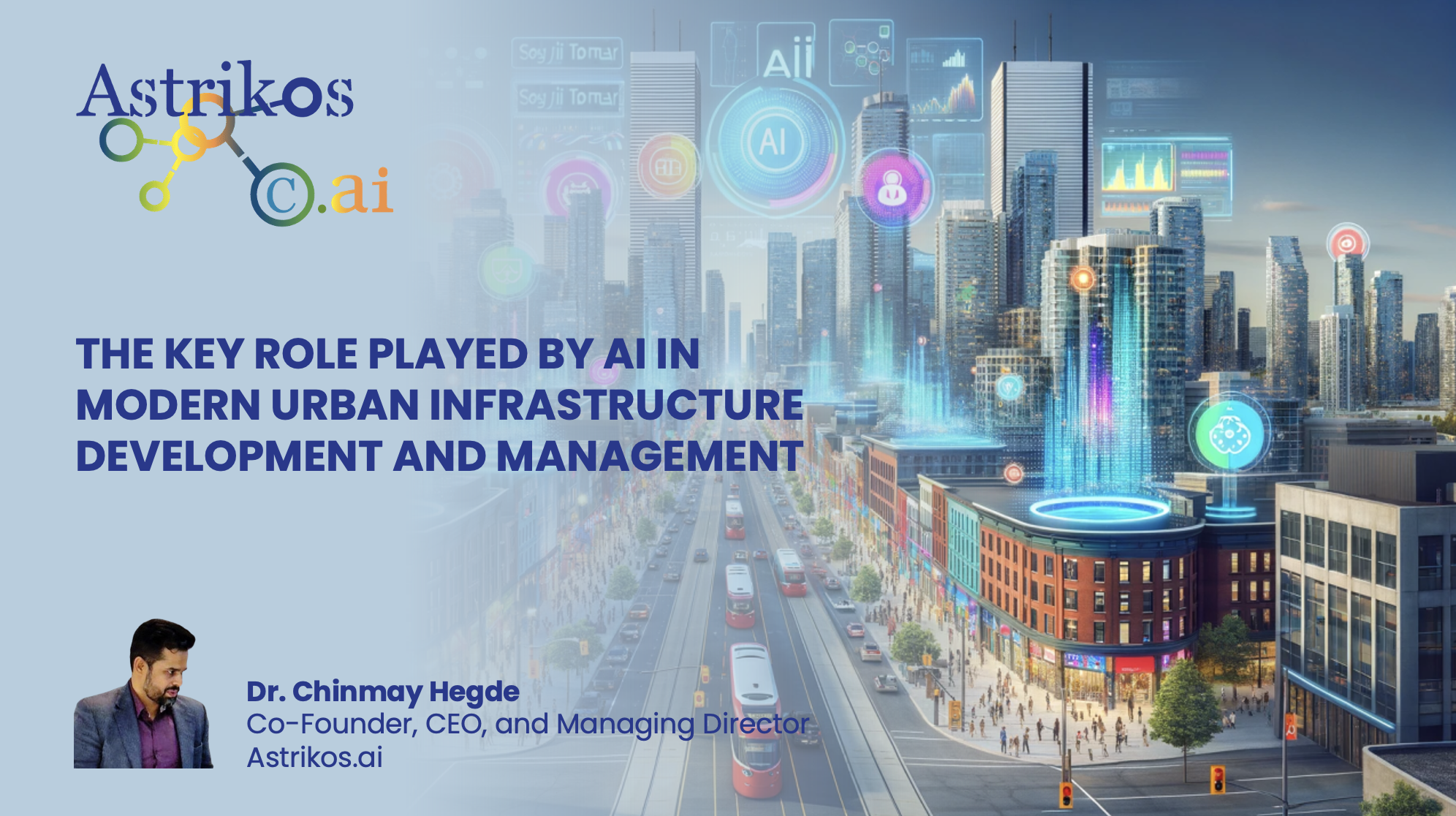The key role played by AI in modern Urban Infrastructure Development and Management - Dr. Chinmay Hegde, Co-Founder, CEO, and Managing Director of Astrikos.ai

Managing
ever-evolving urban infrastructure poses significant challenges across multiple
sectors, including energy, mobility, water, waste management, roads, sewage,
food supply, traffic, safety, and crime. Many cities grapple with aging and
inefficient infrastructure systems, leading to concerns about reliability and
safety. The condition of existing roads, water pipelines, waste collection, and
sewage systems often fails to keep pace with rapid urbanization and the
constant influx of people and vehicles.
Urban mobility is another critical issue, with traffic congestion and outdated public transit networks demanding urgent attention for effective urban management. Additionally, extreme weather events such as heavy rains and heat waves stress the need for climate-resilient infrastructure that can withstand diverse environmental conditions.
Addressing these multifaceted challenges and sustainably planning urban infrastructure necessitates a revolutionary approach. This involves leveraging cutting-edge technologies and implementing innovative solutions to create resilient, efficient, and adaptive urban systems.
The
transformative impact of Artificial Intelligence (AI)
Urban
planning can be tedious and complex when relying on manual processes and
intuition, especially with an exponentially growing population. The integration
of AI offers a sustainable and efficient alternative approach to addressing
these challenges. AI technologies, such as machine learning, urban analytics,
and data-driven decision-making, are transforming urban planning, resource
management, public safety, and environmental sustainability.
AI
empowers urban planners and infrastructure management authorities to build
smarter and more sustainable cities. AI-powered smart cities use cutting-edge
technologies to optimize urban services by analyzing massive volumes of data
generated from public transportation, traffic sensors, crime and accident
records, weather reports, and various government departments. This data can be
effortlessly gathered and evaluated to gain insights that enhance city
operations' efficiency.
With AI, land use can be optimized, and public services can be improved, ultimately enhancing the quality of life for residents. Urban planners can simulate near real-time scenarios for urban developments, and visualize outcomes by factoring in population growth, weather conditions, and other technological advancements.
Transportation
optimization and mobility
Mobility
is a crucial aspect of urban infrastructure planning, as the connection of
people, goods, and services through various transportation modes often leads to
increased pollution, time loss, and revenue decline. Traffic congestion is a
persistent challenge, especially in developing economies. Traditional
intelligent traffic systems rely on condition-based detection and traffic
automation but lack the capability for behavioral analysis of traffic patterns
and feedback integration.
Machine learning-driven AI tools can address this gap by performing geo-temporal analysis of traffic patterns and categorizing zones for better planning. Implementing a geospatial digital twin model allows the seamless integration of zone analytics into existing traffic management and violation detection systems. Advanced applications include data-driven approaches to automating signal times based on traffic patterns, increasing green light durations through signal synchronization across junctions, and enabling free mobility across the city. Additionally, geospatial digital twin intelligence can enhance pedestrian safety and accident control modeling. AI also improves emergency response times, facilitating better emergency movements.
Increase
in energy efficiency
The
ever-increasing demand for energy presents a significant challenge for urban
infrastructure planning. Energy efficiency initiatives are essential for
addressing energy scarcity and promoting environmental sustainability. AI
technology plays a crucial role in this effort by tracking energy consumption
patterns in buildings and public areas, identifying high energy wastage zones,
and implementing conservation solutions to promote better resource allocation
and reduce carbon footprints.
AI-powered smart grids aid in balancing real-time supply and demand and integrating renewable energy sources. AI tools enable automated and sophisticated demand response strategies, helping to balance energy consumption during peak hours. Additionally, AI analyzes data from sensors, smart meters, and IoT devices to identify patterns, predict failures, and enable automatic grid reconfiguration. AI algorithms also optimize energy storage, leading to higher usage of stored energy, cost reduction, and increased integration of renewable sources such as solar and wind power, thus enhancing energy management in smart cities.
Enhances
urban safety
Urban planners and administrators continuously strive to enhance public safety in modern cities. Traditional policing methods, however, often fall short against evolving threats and crime patterns. By leveraging AI-powered tools, authorities can significantly improve existing security infrastructure and boost public safety initiatives. AI and machine learning analyze diverse data sources, providing a comprehensive view to all stakeholders involved in crime management. This technology enables security teams to identify potential threats more effectively, accurately pinpoint crime hotspots and periods, and strategically deploy resources to prevent crimes, increasing the efficiency of urban safety measures. Tools such as facial recognition, weapon detection, and other analytics solutions alert police in real time. AI-powered predictive policing is a notable application of AI in public safety. Additionally, integrating AI tools into connected vehicles alerts drivers in real-time, reducing accident likelihood and enhancing overall road safety. AI can also enhance public safety by predicting heatwaves, floods, and storms, monitoring hazardous waste disposal, and detecting changes in air as well as water quality. During an emergency response, AI tools can support in predicting the impact of natural disasters and can optimize the deployment of resources while coordinating rescue operations.
Integrating
AI into urban infrastructure can transform cities into more efficient,
sustainable, and livable spaces, significantly improving quality of life and
shaping future urban landscapes.
___________________________________________________________________________



